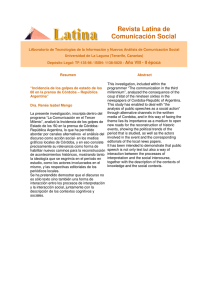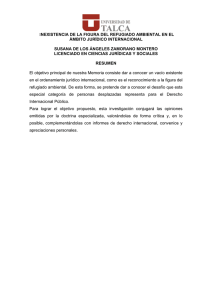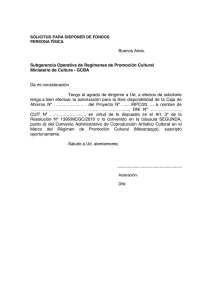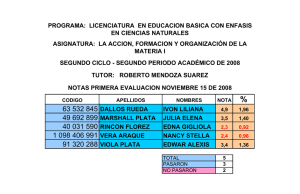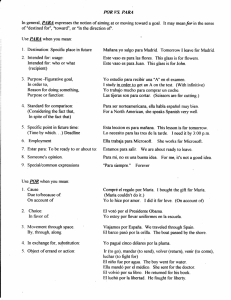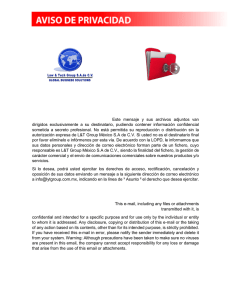El patio tras el incendio 1,45 MB
Anuncio
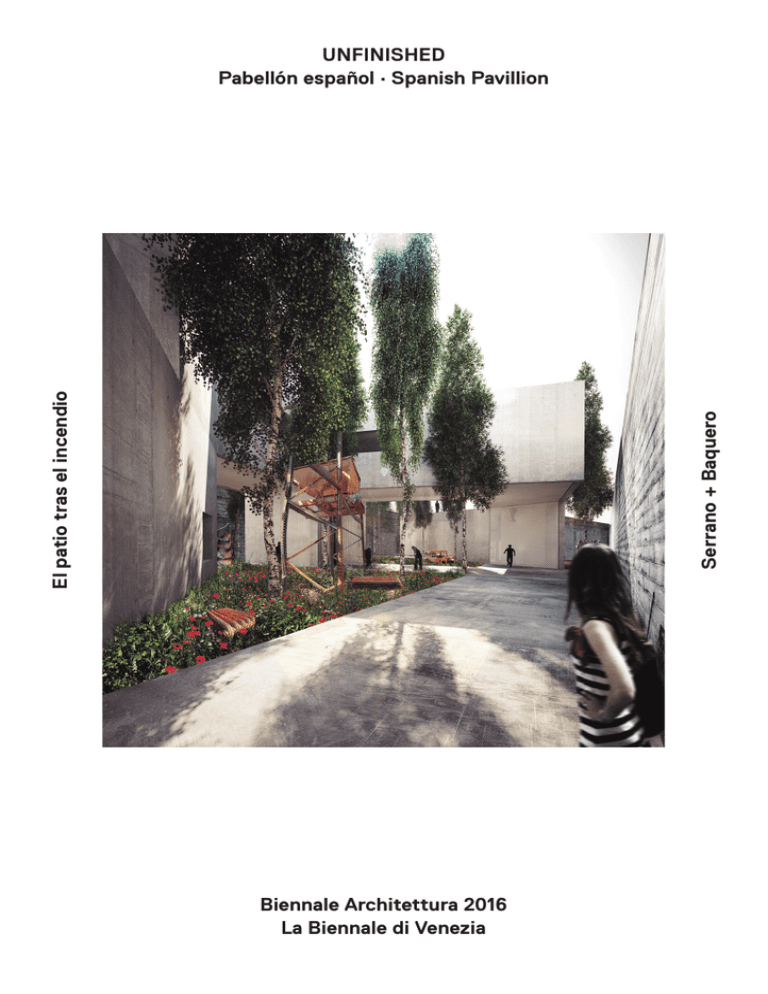
Serrano + Baquero El patio tras el incendio UNFINISHED Pabellón español · Spanish Pavillion Biennale Architettura 2016 La Biennale di Venezia En Diciembre de 2012 parte de la sede de la empresa ATHISA MEDIOAMBIENTE, situada en el polígono industrial de Asegra, sufrió un incendio. La zona de despachos y oficinas quedó intacta mientras que el área industrial, donde se almacenaban diversas mercancías y se realizaba la fabricación de producto, quedó reducida a escombros. Creemos que este hecho accidental puede servir como punto de partida para el proyecto, en lugar de enfrentarnos al solar como un lienzo en blanco, como si nada hubiera pasado. De esta manera, la nueva planta surge a partir de los restos hallados tras el incendio, con el fin de permitir la lectura de la historia de este lugar en las huellas de su actividad y sus transformaciones, tras la intervención. La exploración: Convertidos en exploradores, realizamos diversas visitas antes de que fueran retirados los restos del incendio, reconociendo y registrando los objetos que habían quedado dispersos entre los escombros. Documentamos, almacenamos y limpiamos los elementos que poseían más valor para los trabajadores, que intervinieron en este proceso de recuperación de objetos. Tanto los objetos en sí, oxidados y deformados en escultóricas figuras por la acción del fuego, como los muros y el suelo, nos resultaron de gran interés. En el suelo podía aún leerse la actividad que allí se había realizado: rieles empotrados, marcas de muros, y cuando comenzó la retirada de escombros, las huellas de los mismos estampada, como si del gran vidrio de Duchamp se tratara. El patio sobre los escombros: La propuesta consiste en realidad en consolidar este estado, la memoria de este lugar sacada a la luz Las zonas donde había una mayor acumulación de escombros, que coinciden con los lugares donde se encontraban almacenados los objetos en el pasado, pasan a formar parte de una serie de patios abiertos e 2 In December 2012, of the company headquarters of ATHISA, located in the industrial area of Asegra, suffered a fire. The office area remained intact while the industrial area, where different goods were stored and the manufacturing of chemical products was made, was reduced to rubble. We believe that this accidental fact can be a key point to enrich the project, rather than treating the plot as a blank canvas, as if nothing had happened. In this way, the new plant comes up from the remains found after the fire, in order to allow the reading of the history of this place in the footsteps of the developed activity and its transformations, after the intervention. The exploration: Becoming explorers, we made several visits to the site before the remains of the fire were removed, recognizing and recording the objects that had been scattered among the rubble. We documented, stored and cleaned the elements that had more value to workers, who were involved in this process of recovery of objects. Both the objects themselves, oxidized and sculptural figures deformed by the action of fire, and the walls and floor were of great interest to us. The activity was performed there could still be read on the floor: embedded rails and the marks of the walls once the debris removing began, stamped traces as if it was Duchamp’s great glass. The courtyard over the rubble: The proposal consists in consolidating this state, the memory of this place brought to light. The areas where there was a greater accumulation of debris, which coincide with the locations where the objects were stored in the past, become part of a series of open and interconnected courtyards in which the vegetation emerges and where the recovered objects will be arranged like sculptures that link to the past and to the memories of the workers of the company. 3 interconectados en los que surge vegetación y donde se dispondrán los objetos recuperados a modo de esculturas que enlazan con el pasado y los recuerdos de los trabajadores de la empresa. Una nueva pieza, que contiene las actividades que se realizaban anteriormente en la nave, se apoya en las zonas que estaban vacías y sobrevuela los patios creados, generando actividad a diferentes cotas, poniendo al usuario en relación con diferentes elementos: los objetos calcinados, la nueva vegetación o el paisaje lejano tan olvidado en este polígono industrial. Además, la introducción de un proyecto de estas características en la trama industrial da lugar a nuevas relaciones entre la actividad y el paisaje, ya que lo usual es que, como pasaba antes del incendio en esta misma planta, las ventanas de las oficinas de los trabajadores den al interior de las naves. A través de esta estrategia, mediante la que se aprovecha la cota máxima disponible en el polígono para duplicar la superficie disponible en planta, se libera gran parte de la planta baja de forma que los 3 usos industriales diferenciados se realizan entre los patios sobre los escombros, sirviendo de apoyos, mientras que la nueva zona de oficinas se eleva a una cota más alta para disfrutar de luz natural y la nueva vegetación. El proyecto aprovecha la nueva cubierta como un mirador y como un lugar de descanso para los trabajadores, además de suponer una excelente plataforma para la realización de eventos y actos relacionados con la empresa. La posición elevada, por encima de las cubiertas de las naves del resto del polígono industrial, servirá para disfrutar del paisaje lejano; Sierra Nevada, la Sierra de Huétor, Sierra Elvira y la vega de Granada. 4 A new piece, containing all the activities that were carried out earlier, lies on the areas that were empty and flies over the new courtyards, generating activity at different levels and putting the user in relation to different elements: burned objects, the new vegetation or the distant landscape, totally forgotten in this industrial estate. In addition, the introduction of a project of this nature in the industrial plot leads to new relationships between activity and landscape, as the usual thing in this site is to have the windows of the offices looking and opening to the inside of the industrial plant. Through this strategy, by which the maximum level available in the polygon is used to double the available ground surface, much of the ground floor is released, so the 3 different industrial uses are developed between the yards over the debris, serving as the structural support, while the new office area is rosen to a higher level to enjoy natural light and the new vegetation. The project takes advantage of the new roof as a viewpoint and as a resting place for workers, while being an excellent platform for holding events. The elevated position above the decks of the depots of this industrial site, will serve to enjoy the distant landscape: Sierra Nevada, Sierra de Huétor, Sierra Elvira Vega of Granada. 5 6 7 8 9 10 11 El patio tras el incendio. The courtyard after the fire. 2016 http://unfinished.es/obras/C02.pdf Concurso. Competition Serrano + Baquero
